Principles of Engineering Design
First published November/December 2009.
Copyright 2009 Dr. L.D. Ryan and John L. Ryan
Humpty Dumpty Sat on a Wall... The nursery rhyme involving Humpty Dumpty is a child’s first lesson in safety. What would keep Humpty Dumpty safe as he is sitting on the wall? A warning or a railing? What would prevent the accident of Humpty where all the Kings’ horses and all the Kings’ men couldn’t put Humpty Dumpty together again? If the designer of the wall would have used the design priority list, Humpty may have lived to sit on another wall.
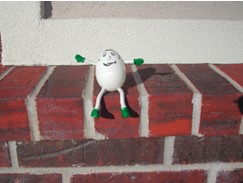
An engineer approaching the problem using the
design priority would have tried to restrict access
to the top of the wall. If this was not possible, a
guard rail would be installed to prevent falls from
the wall. This illustrates the concept of priority in
safety design.
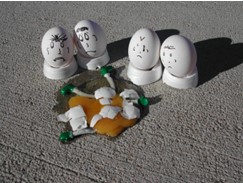
What is the hierarchy of design?
The hierarchy of design, order of design precedence, and design priority all refer to the same process which engineers use to ensure that product hazards are adequately safeguarded.
The first step in safeguarding product hazards is to identify any hazards associated with a product and its use. Hazard analysis techniques use different methods to identify hazards. Once the hazards are identified, the hazards must be dealt with.
The hierarchy of design is a step-by-step process that when followed will make a product as safe as possible. Each step of the hierarchy presents a different method of hazard control each with a different level of effectiveness. The most effective method of hazard control is tried first, if this can’t be implemented for a particular product, the second method of hazard control is used, and so on. Engineers often rely on inferior methods of hazard control when more effective methods have not been used.
The Hierarchy of Design
1. Eliminate the Hazard: The highest priority in the hierarchy of design is to eliminate a hazard from the design, if this is possible. Elimination of the hazard is the most effective method of hazard control. If there is no hazard, there can be no injury. This solution works for anyone, regardless of ability, experience, and behavioral and physical characteristics.
2. Neutralize the hazard: The next most effective method of hazard control is to guard the hazard. Neutralizing the hazard involves using guarding techniques to protect people from the hazard. Some products are inherently dangerous, and elimination of the hazard will be impossible. This occurs when the function of a product results in the hazard. For example, a power saw’s function is to cut wood and other material. Eliminating this hazard would render the product useless. Physical guarding, guarding by distance, control measures, interlocking, presence sensing devices all help to neutralize product hazards.
3. Warnings: The next most effective method of hazard control is warnings. It is always a good idea to provide product warnings even if a hazard has been effectively neutralized with guarding. Warnings should never be used as a primary source of hazard control, however, unless it is impossible to eliminate or safeguard the hazard. Most hazards can be eliminated or safeguarded. Warnings are easily ignored or tuned out by product users, making their effectiveness minimal.
4. Training/Behavior Modification: The next most effective method of hazard control is to train product users on proper operation and to encourage safe working practices in an attempt to prevent injuries. This method of hazard control is not to be relied upon. Training involves teaching product users new, safe ways to use a product. People learn in different ways, at different speeds. People also easily forget, suffer from distraction and inattention. While training is not appropriate for a primary method of hazard control, it should be used if the first three methods of hazard control cannot be implemented. Training, as well as the other methods of hazard control, can supplement other methods used, increasing the overall safety of the product.
5. Protective Equipment: Protective equipment is a last resort method of hazard control. This method should only be relied on when all other methods cannot be used. This method of hazard control does not involve reducing the hazardousness of a product, protecting the operator from the hazards of a product, or using warnings or training to alter how a product is used. Protective equipment will only reduce the severity of injuries when the operator is exposed to the hazard.
Who Uses This Method?
Any conscientious engineer uses this process, or a similar method, to protect the user of the product. Professional engineers are bound by their code of ethics—the first canon of which is to protect the health, welfare, and safety of the public.
The National Safety Council, a recognized leader in the safety industry, refers to this process as the order of design precedence in its Accident Prevention Manual. They state to first design for minimum risk, then to incorporate safety devices, then to provide warnings, then to develop operating procedures and training programs. The final option is to use personal protective equipment.
The American Society of Mechanical Engineers details this process in a publication entitled “An Instructional Aid for Occupational Safety and Health in Mechanical Engineering Design.” Their order of preference varies slightly from other sources. ASME’s design priority includes first eliminating the hazard from the product. The second priority is to control the hazard by guarding, while the third is to train personnel to identify and be aware of the hazard and how to avoid the hazard. The fourth priority is warnings, while the fifth priority calls for the designer to anticipate how the user will abuse the product and to minimize consequences associated with these misuses of the product. The last method of hazard control is using protective equipment.
Thomas A. Hunter, in his book Engineering Design for Safety, identifies three methods of hazard control. These include designing a hazard out of a product, providing guards for hazards that cannot be designed out, and to provide warnings or instructions to notify the user of the hazards of a product.
An Example of the Design Process
This process can be better explained with an example. All-terrain vehicles are a product that see frequent accidents. A competent engineer would first identify the hazards associated with the product by performing a hazard analysis (this will be detailed in a later Forensic Clues).
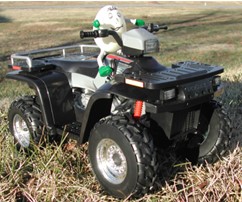
The engineer would identify several hazards with the ATV. One of the most dangerous hazards of ATV’s is the hazard of being crushed in an overturn.
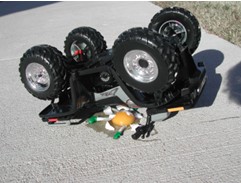
The designer should first attempt to eliminate
the hazards by design. While completely
eliminating the possibility of overturning
ATV’s may be difficult to achieve, the hazard of overturn can be minimized at the de
sign level. The location of the center of
gravity has a substantial effect on the likelihood of an ATV to overturn.
By reducing the center of gravity of the ATV
as much as possible, the chance of overturning is minimized. Another factor that can be
affected at the design level is the presence of
differentials. Differentials allow inner and
outer wheels to turn at different speeds during turning, facilitating the turning process.
Most ATV manufacturers do not use rear differentials. Operators must oversteer
to get the ATV to turn. This can cause
rollovers due to the dynamics of ATV’s,
especially when a change of surface is
encountered during a turn. By adding a
rear differential, the ATV will be easier
to steer, and will be less likely to overturn.
Once everything that can be done to re
duce hazards at a design level has been
done, the next priority of design must be
used. Since there is still risk of overturning the ATV, neutralization of the hazard must be accomplished with guarding.
Guarding against overturn involves adding a roll-over protective structure
(ROPS) and a seatbelt. These safety
devices help ensure that an operator will
be protected in an overturn.
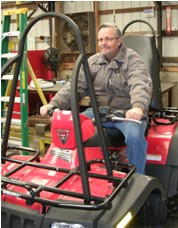
Since the hazard of overturn has been
minimized through design, and neutralized with roll over protection and a seat
belt, the other design priorities are not
required. Many ATV manufacturers
have failed to safeguard against the hazard of rollover accidents, instead choosing less effective, lower priority methods
of hazard control. Many ATV manufacturers warn about the hazard of overturns
without providing proper safeguards.
Warnings do little to prevent overturns.
Some manufacturers opt to offer training
courses to attempt to reduce ATV over
turns through operator training. Other
manufacturers rely on operator protective equipment of a helmet to protect the
operator.
How We Can Help
At MASE, we can help apply engineering design principles including the hierarchy of design and hazard assessments to your accident case. To be critical of a design implies an alternative, safer design, which is something we can help you identify, whether it is already in the stream of commerce, or if there is adequate technology to increase the safety of a product, machine, or process. We offer full service mechanical engineering expert witness services from machine inspection to trial testimony. Call us at (855) 627-6273 or email us at info@mase.pro